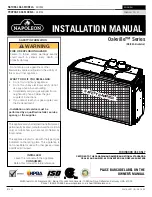
© Banner Engineering Corp. www.bannerengineering.com
3
B
ANNER
E
NGINEERING
C
ORP
LTF T
IME
OF
F
LIGHT
L
ASER
D
ISTANCE
S
ENSOR
Q
UICK
S
TART
G
UIDE
Sensor Installation
NOTE
:
Handle the sensor with care during installation and operation. Sensor windows soiled by fingerprints, dust, water, oil, etc. may create stray
light that may degrade the peak performance of the sensor. Blow the window clear using filtered, compressed air, then clean as necessary using
70% isopropyl alcohol and cotton swabs or water and a soft cloth.
Mount the Device
1.
If a bracket is needed, mount the device onto the bracket.
2.
Mount the device (or the device and the bracket) to the machine or equipment at the desired location. Do not tighten the mounting
screws at this time.
3.
Check the device alignment.
4.
Tighten the mounting screws to secure the device (or the device and the bracket) in the aligned position.
Wiring Diagrams
Sensor Programming
Program the sensor using the buttons on the sensor or the remote input (limited programming options).
From Run mode, use the buttons to access the Quick Menu and the Sensor Menu. See
, , and the instruction manual (p/n
194135) for more information on the options available from each menu. For TEACH options, follow the TEACH instructions in the instruction
manual.
In addition to programming the sensor, use the remote input to disable the buttons for security, preventing unauthorized or accidental program
-
ming changes. See the instruction manual for more information.
Class 2 Lasers
Class 2 lasers are lasers that emit visible radiation in the wavelength range from 400 nm to 700 nm, where eye
protection is normally afforded by aversion responses, including the blink reflex. This reaction may be expected
to provide adequate protection under reasonably foreseeable conditions of operation, including the use of optical
instruments for intrabeam viewing.
Figure 3:
FDA (CDRH) warning label
(Class 2)
Class 2 Laser Safety Notes
Low-power lasers are, by definition, incapable of causing eye injury within the duration of a blink (aversion
response) of 0.25 seconds. They also must emit only visible wavelengths (400 to 700 nm). Therefore, an ocular
hazard may exist only if individuals overcome their natural aversion to bright light and stare directly into the laser
beam.
Figure 4:
Analog Current Model
Figure 5:
Analog Voltage Model
Key
1 = Brown
2 = White
3 = Blue
4 = Black
5 = Gray
shield
+
12-30V dc
D_Out
A_Out
Input
–
Load
* User-configurable PNP/NPN setting
4-20 mA
3
1
2
4
5
NPN
or
PNP
shield
+
12-30V dc
D_Out
A_Out
Input
–
Load
* User-configurable PNP/NPN setting
3
1
2
4
5
NPN
or
PNP
0-10V
2
3
4
1
5



























